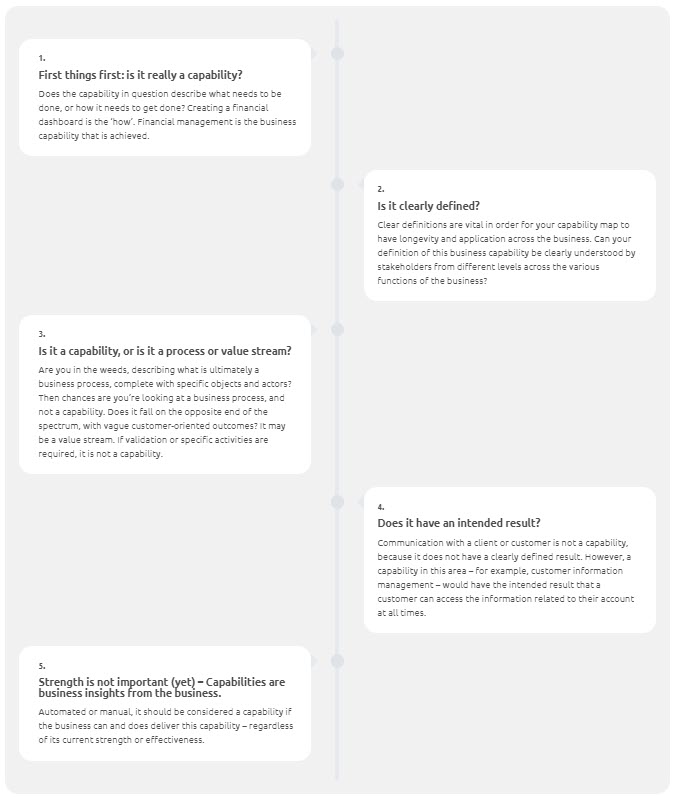Business Capabilities: an introduction to the Business Capability Model
From SMB to Enterprise, national to global – digital transformation is a necessity for any company that wants to remain competitive in ever-changing markets. Implementing digital transformation across an organization is a long and intensive process that brings consequences and impact for the entire organization. That’s why a clear strategy and a structured approach is crucial for success. Transformation by its nature signifies change, and while that change is absolutely necessary, structure is also vital to stay on track and bring the entire company along. So how do you balance change with structure? And where do you begin? It starts with working out your business capabilities.
Where to start: Business capabilities
Business capabilities are the lasting, cross- domain or function elements present in an organization that play a role in realizing various business outcomes. All businesses, large and small, function using a set of interacting business capabilities. In modern enterprises, these business capabilities are numerous and complex, and are increasingly integrated and automated through the use of technology.
Business capabilities are defined by The Open Group’s standard architecture methodology, TOGAF, as “an ability that an organization, person, or system possesses. Capabilities are typically expressed in general and high-level terms and typically require a combination of organization, people, processes, and technology to achieve.”
Examples of business capabilities could be recruitment, pricing, risk management or product design.
Building blocks
Business capabilities are the building blocks that allow a company or organization to deliver its products or services and ultimately, value to the customer. Business capabilities come in many flavors – ‘hard’ (manufacturing, invoicing) or ‘soft’ (innovation, talent development), ‘core’ (software development) or ‘contextual’ (qualifying sales and marketing leads). There are a wealth of ways to slice and dice business capabilities – but no matter the approach, companies must go through the process of business capability mapping.
When defining the capabilities for your organization, you are going to need to think in terms of what needs to be done or what the organization needs to be able to do to be successful. It is not yet important how this will be done or what it takes in terms of people, processes or resources. The capability answers the “what” question and leaves the “how” question aside. Starting with identifying the business capabilities means the question of ‘how’ can eventually be answered.
Determining whether or not something is a business capability, differentiating one capability from another and validating them within the context of your specific business model can be challenging.
Business capabilities guidelines
Use the following guidelines as a high-level starting point to help you identify and differentiate your business capabilities:

Business Capability Model
Of course, identifying business capabilities on their own does not yet give you real insight of what an organization is capable of. To see the fuller picture, it’s important to capture the business capabilities in an orderly and structured way, and to document their relationships and hierarchy in the form of a Business Capability Model.
We all know the importance of demonstrating the value of Enterprise Architecture to your stakeholders, and a Business Capability Model is key to helping you tell this story in a clear and simple way. The Business Capability Model goes beyond the factors that are often discussed when transforming from an old approach to a new desired approach. Topics including political agendas, missing skills, or a lack of resources are not taken into account when creating a Business Capability Model, and it enables you as an architect to put all organizational capabilities in context.
Let’s look at a quick analogy to help illustrate the concept. A construction plan describes what a new neighborhood or building should look like. Similarly, a Business Capability Model describes how an organization will ideally look and operate through its constituent parts.
Business Capability Model example in BlueDolphin
A Business Capability Model provides an overview of what is important to the business. They offer the following benefits:
– A shared language: The Business Capability Model can be used to align business objectives with processes that are then enabled through information technology.
– Organizational neutrality: Changes in the organization do not affect the prior analysis.
– The ability to Identify what is strategically important: Strategic issues and objectives can be mapped against opportunities, providing a powerful visual tool that facilitates decision making.
– More focus on improvement opportunities: The Business Capability Model helps to prioritize process and system improvement efforts by linking them to the capabilities that most need improvement or have the greatest strategic impact.
– An accurate reflection of program scope: Mapping program objectives to capabilities provides a more complete and accurate picture of the true scope.
Of course, this is a high-level overview to help get you thinking about your approach to business capabilities and creating a Business Capability Model. But as you can see from some of the benefits highlighted above, your Business Capability Model will serve as an important foundation for digital transformation projects including Application Portfolio Management, Business Process Management and Project & Portfolio Architecture. For organizations that are embarking on an Agile Business Transformation journey, business capability mapping is certainly an important place to start.
To learn more about Agile Business Transformation and some of it’s key enablers, take a look at our eBook: Why Digital Transformation Fails
eBook: Why Digital Transformation Fails
Did you ever have to terminate a (transformation) project half-way through? Or did an initiative fail to deliver the expected results? Unfortunately, these things happen – but they don’t have to!
We identified the 4 reasons why digital transformation often fails in our latest eBook. Be aware of the pitfalls and recognize the early signs of a failing project to keep things on the right track.
















![Toni Kroos là ai? [ sự thật về tiểu sử đầy đủ Toni Kroos ]](https://evbn.org/wp-content/uploads/New-Project-6635-1671934592.jpg)


